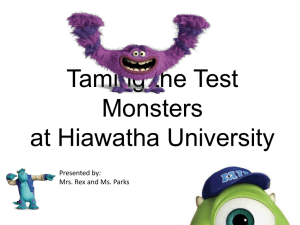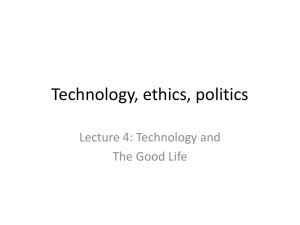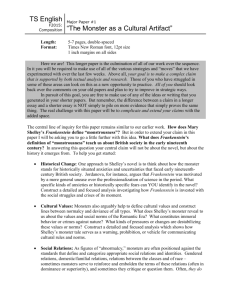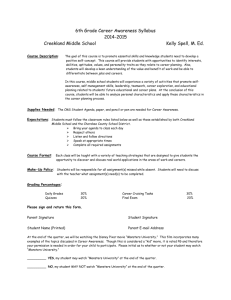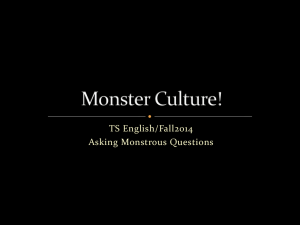Jykell CISM - RiverCenter for the Performing Arts
advertisement
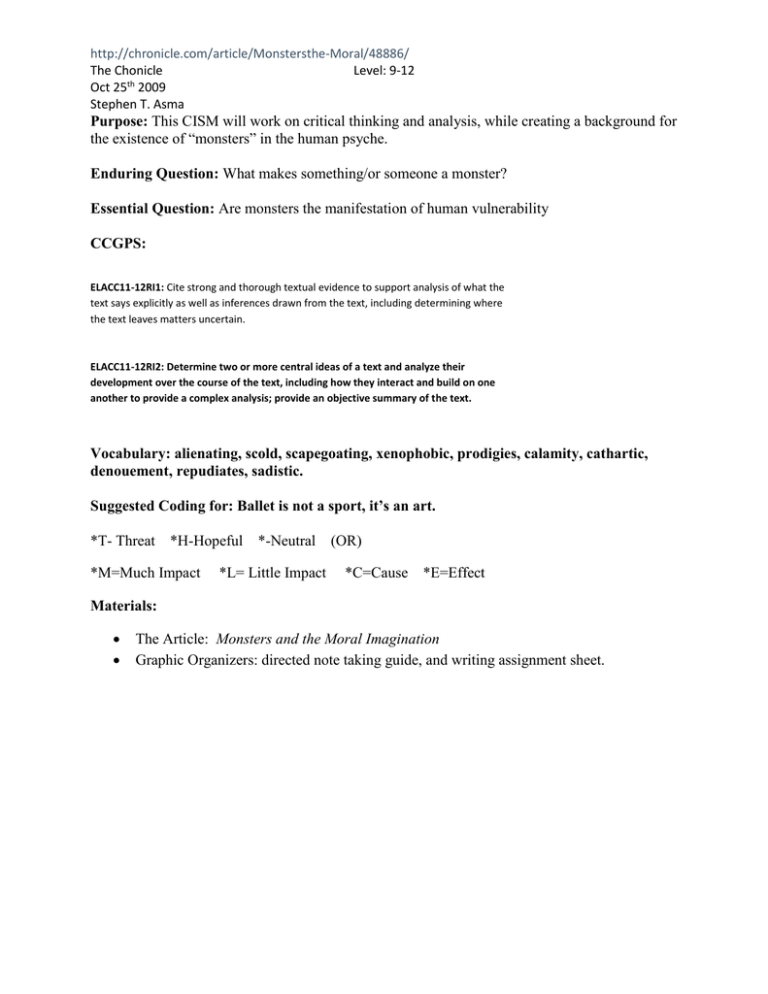
http://chronicle.com/article/Monstersthe-Moral/48886/ The Chonicle Level: 9-12 th Oct 25 2009 Stephen T. Asma Purpose: This CISM will work on critical thinking and analysis, while creating a background for the existence of “monsters” in the human psyche. Enduring Question: What makes something/or someone a monster? Essential Question: Are monsters the manifestation of human vulnerability CCGPS: ELACC11-12RI1: Cite strong and thorough textual evidence to support analysis of what the text says explicitly as well as inferences drawn from the text, including determining where the text leaves matters uncertain. ELACC11-12RI2: Determine two or more central ideas of a text and analyze their development over the course of the text, including how they interact and build on one another to provide a complex analysis; provide an objective summary of the text. Vocabulary: alienating, scold, scapegoating, xenophobic, prodigies, calamity, cathartic, denouement, repudiates, sadistic. Suggested Coding for: Ballet is not a sport, it’s an art. *T- Threat *H-Hopeful *M=Much Impact *-Neutral *L= Little Impact (OR) *C=Cause *E=Effect Materials: The Article: Monsters and the Moral Imagination Graphic Organizers: directed note taking guide, and writing assignment sheet. http://chronicle.com/article/Monstersthe-Moral/48886/ The Chonicle Level: 9-12 th Oct 25 2009 Stephen T. Asma Procedure Suggested Time 0-10 minutes Teacher Will Facilitate discussion on the enduring question. Student will Breakup into small groups to discuss the question then come together for group discussion. 10-20 Teacher will front load the article’s vocabulary 20-40 Students will define the vocabulary terms either through context clues or searching for the words definition. This may be done via internet search, smartphone, or dictionary. Students will take notes and mark coding. Stopping for group discussion on why they choose any given code. Teacher will read the text and model the text coding through paragraph 6. After paragraph 6, teacher will read orally stopping (students may practice fluency) at the bold subtitles to discuss coding. (Optional popcorn read with students) Students will fill out their DirectedNote-Taking graphic organizer. 40-50 Students will create “I wonder questions” from the text. 50-55 60-75 Teacher will facilitate answering and discussion activities. *Deposit/Withdrawal *The Lottery *Stand and Whip *Popcorn 80 Closing activity teacher will post a multiple choice question for the final group discussion Teacher will assign final responses 85 Students will choose the BEST possible answer and discuss. Take home for homework, or do as a warm-up next class. ` http://chronicle.com/article/Monstersthe-Moral/48886/ The Chonicle Level: 9-12 th Oct 25 2009 Stephen T. Asma Using the information from the text to support your answer, which of the following best describes the author’s purpose? A. Monsters are real and should be taken seriously B. Monsters theory should be abandoned, an society should move forward C. The term monsters is relative, and it forces humanity to face its truth D. The category of monster is real, wide, and relative to human interaction. Extended Writing: RAFT Writing assignment: Role: author Audience: readers Format: short stories Topic: Living Nightmares Extended Writing RAFT writing assignment Role: patient Audience: Doctors Format: journal Topic: Triggers for you good/bad side http://chronicle.com/article/Monstersthe-Moral/48886/ The Chonicle Level: 9-12 th Oct 25 2009 Stephen T. Asma MAIN IDEAS Main idea Details http://chronicle.com/article/Monstersthe-Moral/48886/ The Chonicle Level: 9-12 th Oct 25 2009 Stephen T. Asma October 25, 2009 Monsters and the Moral Imagination Melinda Beck Enlarge Image By Stephen T. Asma 1 2 Monsters are on the rise. People can't seem to get enough of vampires lately, and zombies have a new lease on life. This year and next we have the release of the usual horror films like Saw VI and Halloween II; the campy mayhem of Zombieland; morepensive forays like 9 (produced by Tim Burton and Timur Bekmambetov), The Wolfman, and The Twilight Saga: New Moon; and, more playfully, Where the Wild Things Are (a Dave Eggers rewrite of the Maurice Sendak classic). The reasons for this increased monster culture are hard to pin down. Maybe it's social anxiety in the post-9/11 decade, or the conflict in Iraq—some think there's an uptick in such fare during wartime. Perhaps it's the economic downturn. The monster proliferation can be explained, in part, by exploring the meaning of monsters. Popular culture is re-enchanted with meaningful monsters, and even the eggheads are stroking their chins—last month saw the seventh global conference on Monsters and the Monstrous at the University of Oxford. http://chronicle.com/article/Monstersthe-Moral/48886/ The Chonicle Level: 9-12 th Oct 25 2009 Stephen T. Asma 3 4 5 The uses of monsters vary widely. In our liberal culture, we dramatize the rage of the monstrous creature—and Frankenstein's is a good example—then scold ourselves and our "intolerant society" for alienating the outcast in the first place. The liberal lesson of monsters is one of tolerance: We must overcome our innate scapegoating, our xenophobic tendencies. Of course, this is by no means the only interpretation of monster stories. The medieval mind saw giants and mythical creatures as God's punishments for the sin of pride. For the Greeks and Romans, monsters were prodigies—warnings of impending calamity. After Freud, monster stories were considered cathartic journeys into our unconscious—everybody contains a Mr. Hyde, and these stories give us a chance to "walk on the wild side." But in the denouement of most stories, the monster is killed and the psyche restored to civilized order. We can have our fun with the "torture porn" of Leatherface and Freddy Krueger or the erotic vampires, but this "vacation" to where the wild things are ultimately helps us return to our lives of quiet repression. Any careful reading of Bram Stoker's Dracula, for example, will reveal not only a highly sexualized description of blood drinking, but an erotic characterization of the count himself. Even John Polidori's original 1819 vampire tale The Vampyre describes the monster as a sexually attractive force. According to the critic Christopher Craft, Gothic monster tales—Frankenstein, The Strange Case of Dr. Jekyll and Mr. Hyde, Dracula, Anne Rice's Vampire Chronicles—rehearse a similar story structure. "Each of these texts first invites or admits a monster, then entertains and is entertained by monstrosity for some extended duration, until in its closing pages it expels or repudiates the monster and all the disruption that he/she/it brings," he writes. http://chronicle.com/article/Monstersthe-Moral/48886/ The Chonicle Level: 9-12 th Oct 25 2009 Stephen T. Asma 6 7 8 A crucial but often-ignored aspect of monsterology is the role those beasties play in our moral imaginations. Recent experimental moral psychology has given us useful tools for looking at the way people actually do their moral thinking. Brain imaging, together with hypothetical ethical dilemmas about runaway trolley cars, can teach us a lot about our real value systems and actions. But another way to get at this subterranean territory is by looking at our imaginative lives. Monsters can stand as symbols of human vulnerability and crisis, and as such they play imaginative foils for thinking about our own responses to menace. Part of our fascination with serial-killer monsters is that we (and our loved ones) are potentially vulnerable to sadistic violence—never mind that statistical probability renders such an attack almost laughable. Irrational fears are decidedly unfunny. We are vulnerable to both the inner and the outer forces. Monster stories and films only draw us in when we identify with the persons who are being chased, and we tacitly ask ourselves: Would I board up the windows to keep the zombies out or seek the open water? Would I go down to the basement after I hear the thump, and if so, would I bring the butcher knife or the fireplace poker? What will I do when I am vulnerable? The comedy writer Max Brooks understands that dimension of monster stories very well. In books like The Zombie Survival Guide and World War Z, Brooks gives us painstaking, haunting, and hilarious advice about how best to meet our undead foes. For its April Fools' edition, the otherwise serious journal Archaeology interviewed Brooks, asking him (tongue firmly in cheek): "Does the archaeological record hold any zombie-related lessons for us today? What can our ancestors teach us about meeting and, ultimately, defeating the undead menace?" Brooks replied: "The greatest lesson our ancestors have to teach us is to remain both vigilant and unafraid. We must endeavor to emulate the ancient Romans; calm, efficient, treating zombies as just one more item on a rather mundane checklist. Panic is the undead's greatest ally, doing far more damage, in some cases, than the creatures themselves. The goal is to be prepared, not scared, to use our heads, and cut off theirs." http://chronicle.com/article/Monstersthe-Moral/48886/ The Chonicle Level: 9-12 th Oct 25 2009 Stephen T. Asma 1 9 10 11 Brooks is unparalleled in parodying a well-worn monster tradition, but he wouldn't be so funny if we weren't already using monster stories to imagine strategies for facing enemies. The monster is a virtual sparring partner for our imagination. How will I avoid, assuage, or defeat my enemy? Will I have grace under pressure? Will I help others who are injured? Or will I be that guy who selfishly goes it alone and usually meets an especially painful demise? In a significant sense, monsters are a part of our attempt to envision the good life or at least the secure life. Our ethical convictions do not spring fully grown from our heads but must be developed in the context of real and imagined challenges. In order to discover our values, we have to face trials and tribulation, and monsters help us imaginatively rehearse. Imagining how we will face an unstoppable, powerful, and inhuman threat is an illuminating exercise in hypothetical reasoning and hypothetical feeling. You can't know for sure how you will face a headless zombie, an alien face-hugger, an approaching sea monster, or a chainsaw-wielding psycho. Fortunately, you're unlikely to be put to the test. But you might face similarly terrifying trials. You might be assaulted, be put on the front lines of some war, or be robbed, raped, or otherwise harassed and assailed. We may be lucky enough to have had no real acquaintance with such horrors, but we have all nonetheless played them out in our mind's eye. And though we can't know for sure how we'll face an enemy soldier or a rapist, it doesn't stop us from imaginatively formulating responses. We use the imagination in order to establish our own agency in chaotic and uncontrollable situations. People frequently underestimate the role of art and imagery in their own moral convictions. Through art (e.g., Shelley's Frankenstein, Hitchcock's Psycho, King's and Kubrick's The Shining), artists convey moral visions. Audiences can reflect on them, reject or embrace them, take inspiration from them, and otherwise be enriched beyond the entertainment aspect. Good monster stories can transmit moral truths to us by showing us examples of dignity and depravity without preaching or proselytizing. http://chronicle.com/article/Monstersthe-Moral/48886/ The Chonicle Level: 9-12 th Oct 25 2009 Stephen T. Asma 12 13 14 But imagining monsters is not just the stuff of fiction. Picture yourself in the following scenario. On the evening of August 7, 1994, Bruce Shapiro entered a coffee bar in New Haven, Conn. Shapiro and his friends had entered the cafe and were relaxing at a table near the front door. Approximately 15 other people were scattered around the bar, enjoying the evening. One of Shapiro's friends went up to the bar to get drinks. "Suddenly there was chaos," Shapiro explained in The Nation the next year, "as if a mortar shell had landed." He looked up to see a flash of metal and people leaping away from a thin, bearded man with a ponytail. Chairs and tables were knocked over, and Shapiro protected one of his friends by pulling her to the ground. In a matter of minutes, the thin man, Daniel Silva, had managed to stab and seriously injure seven people in the coffee shop. Using a six-inch hunting knife, Silva jumped around the room and attacked with lightning speed. Two of Shapiro's friends were stabbed. After helping some others, Shapiro finally escaped the cafe. "I had gone no more than a few steps," he recalled, "when I felt a hard punch in my back followed instantly by the unforgettable sensation of skin and muscle tissue parting. Silva had stabbed me about six inches above my waist, just beneath my rib cage." Shapiro fell to the pavement and cried out, "Why are you doing this?" Standing over him, Silva plunged the knife into Shapiro's chest, beneath his left shoulder. "You killed my mother" was the incoherent response that Silva offered his victim. Silva then pulled the knife out of Shapiro and rode off on a bicycle. He was soon apprehended and jailed. http://chronicle.com/article/Monstersthe-Moral/48886/ The Chonicle Level: 9-12 th Oct 25 2009 Stephen T. Asma 15 16 17a Was Silva a monster? Not exactly. He was a mentally ill man who snapped and seemed to think that his mother had been wronged and felt some obscure need to avenge her. (She was, in fact, in a nearby hospital at the time, being treated for diabetes.) But from the perspective of raw experience, this horrifying event shares many qualities with the imagined monster attack. Shapiro and his unfortunate company were suddenly presented with a deadly, irrational, powerful force that sent them reeling for mere survival. And yet the victims demonstrated an impressive ability to reach out and help each other. While the victims were leaping away from Silva's angry knife blade, I suspect that he was for them, practically speaking, a true monster. I would never presume to correct them on that account. In such circumstances, many of us are sympathetic to the use of the monster epithet. One of the fascinating aspects of Shapiro's experience is how people responded to his story after the fact. I have been suggesting that monster stories are encapsulations of the human feeling of vulnerability—the monster stories offer us the "disease" of vulnerability and its possible "cures" (in the form of heroes and coping strategies). Few monster stories remain indefinitely in the "threat phase." When fear is at a fever pitch, they always move on to the hero phase. Hercules slays the Hydra, George slays the dragon, medicine slays the alien virus, the stake and crucifix slay the vampire. Life and art mutually seek to conquer vulnerability. "Being a victim is a hard idea to accept," Shapiro explained, "even while lying in a hospital bed with tubes in veins, chest, penis, and abdomen. The spirit rebels against the idea of oneself as fundamentally powerless." This natural rebellion may have prompted the most repeated question facing Shapiro when he got out of the hospital. When people learned of Daniel Silva's attack on seven victims, they asked, "Why didn't anyone try to stop him?" Shapiro always tried to explain how fast and confusing the attack was, but people failed to accept this. Shapiro, who was offended by the question, says, "The question carries not empathy but an implicit burden of blame; it really asks 'Why didn't you stop him?' It is asked http://chronicle.com/article/Monstersthe-Moral/48886/ The Chonicle Level: 9-12 th Oct 25 2009 Stephen T. Asma 17b 18 19 20 because no one likes to imagine oneself a victim." We like to see ourselves as victors against every threat, but of course that's not reality. Believers in human progress, from the Enlightenment to the present, think that monsters are disappearing. Rationality will pour its light into the dark corners and reveal the monsters to be merely chimeric. A familiar upshot of the liberal interpretation of monsters is to suggest that when we properly embrace difference, the monsters will vanish. According to this view, the monster concept is no longer useful in the modern world. If it hangs on, it does so like an appendix—useful once but hazardous now. I disagree. The monster concept is still extremely useful, and it's a permanent player in the moral imagination because human vulnerability is permanent. The monster is a beneficial foe, helping us to virtually represent the obstacles that real life will surely send our way. As long as there are real enemies in the world, there will be useful dramatic versions of them in our heads. In 2006, four armed men in Kandahar, Afghanistan, broke into the home of an Afghan headmaster and teacher named Malim Abdul Habib. The four men held Habib as they gathered his wife and children together, forcing them to watch as they stabbed Habib eight times and then decapitated him. Habib was the headmaster at Shaikh Mathi Baba high school, where he educated girls along with boys. The Taliban militants of the region, who are suspected in the beheading, see the education of girls as a violation of Islam (a view that is obviously not shared by the vast majority of Muslims). My point is simply this: If you can gather a man's family together at gunpoint and force them to watch as you cut off his head, then you are a monster. You don't just seem like one; you are one. http://chronicle.com/article/Monstersthe-Moral/48886/ The Chonicle Level: 9-12 th Oct 25 2009 Stephen T. Asma 21 22 23 A relativist might counter by pointing out that American soldiers at Abu Ghraib tortured some innocent people, too. That, I agree, is true and astoundingly shameful, but it doesn't prove there are no real monsters. It only widens the category and recognizes monsters on both sides of an issue. Two sides calling each other monsters doesn't prove that monsters don't exist. In the case of the American torturer at Abu Ghraib and the Taliban beheader in Afghanistan, both epithets sound entirely accurate. My own view is that the concept of monster cannot be erased from our language and thinking. It cannot be replaced by other more polite terms and concepts, because it still refers to something that has no satisfactory semantic substitute or refinement. The term's imprecision, within parameters, is part of its usefulness. Terms like "monster" and "evil" have a lot of metaphysical residue on them, left over from the Western traditions. But even if we neuter the term from obscure theological questions about Cain, or metaphysical questions about demons, the language still successfully expresses a radical frustration over the inhumanity of some enemy. The meaning of "monster" is found in its context, in its use. So this Halloween season, let us, by all means, enjoy our fright fest, but let's not forget to take monsters seriously, too. I'll be checking under my bed, as usual. But remember, things don't strike fear in our hearts unless our hearts are already seriously committed to something (e.g., life, limb, children, ideologies, whatever). Ironically then, inhuman threats are great reminders of our own humanity. And for that we can all thank our zombies. Stephen T. Asma is a professor of philosophy at Columbia College Chicago. Oxford University Press is publishing his most recent book, On Monsters: An Unnatural History of Our Worst Fears, this month.
